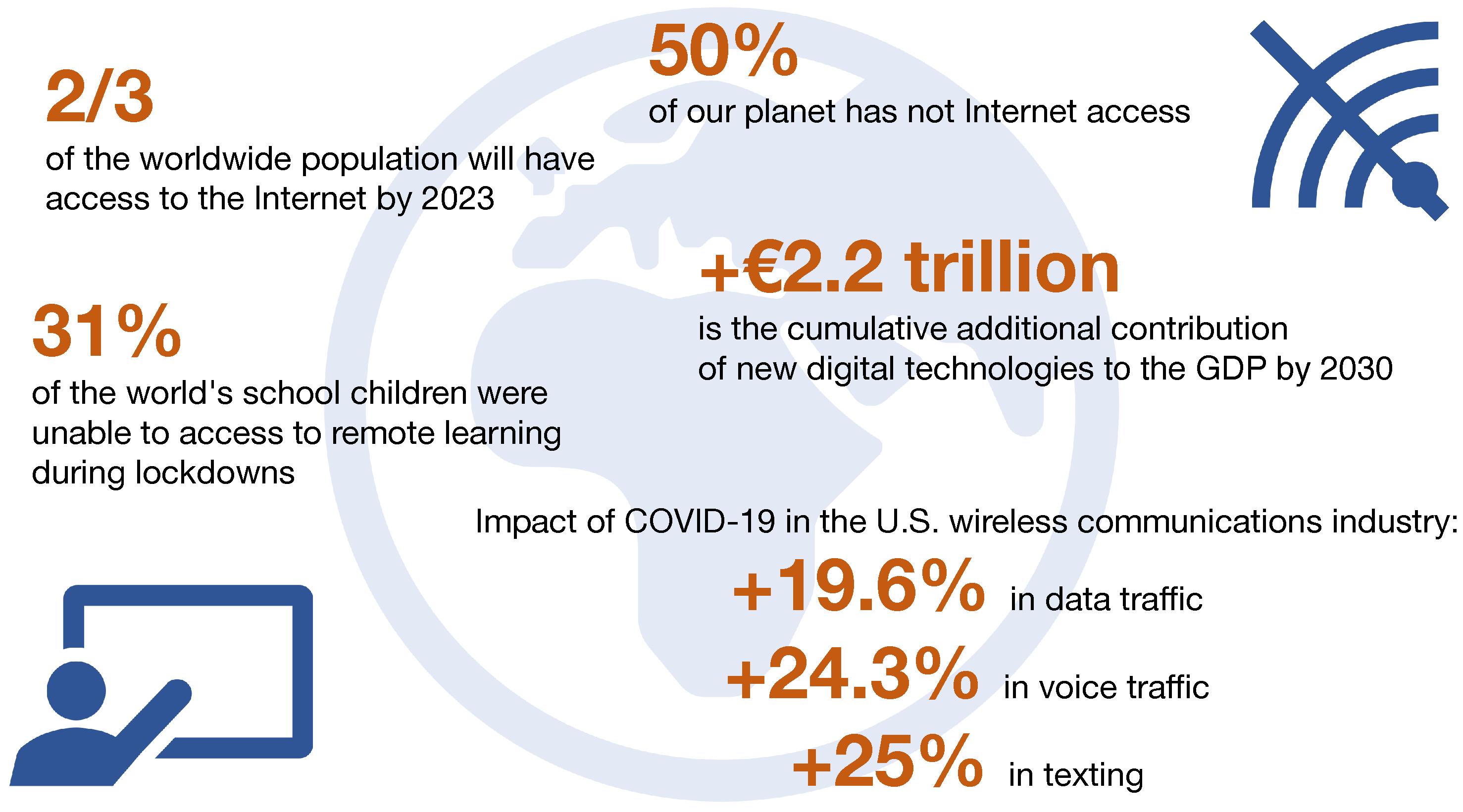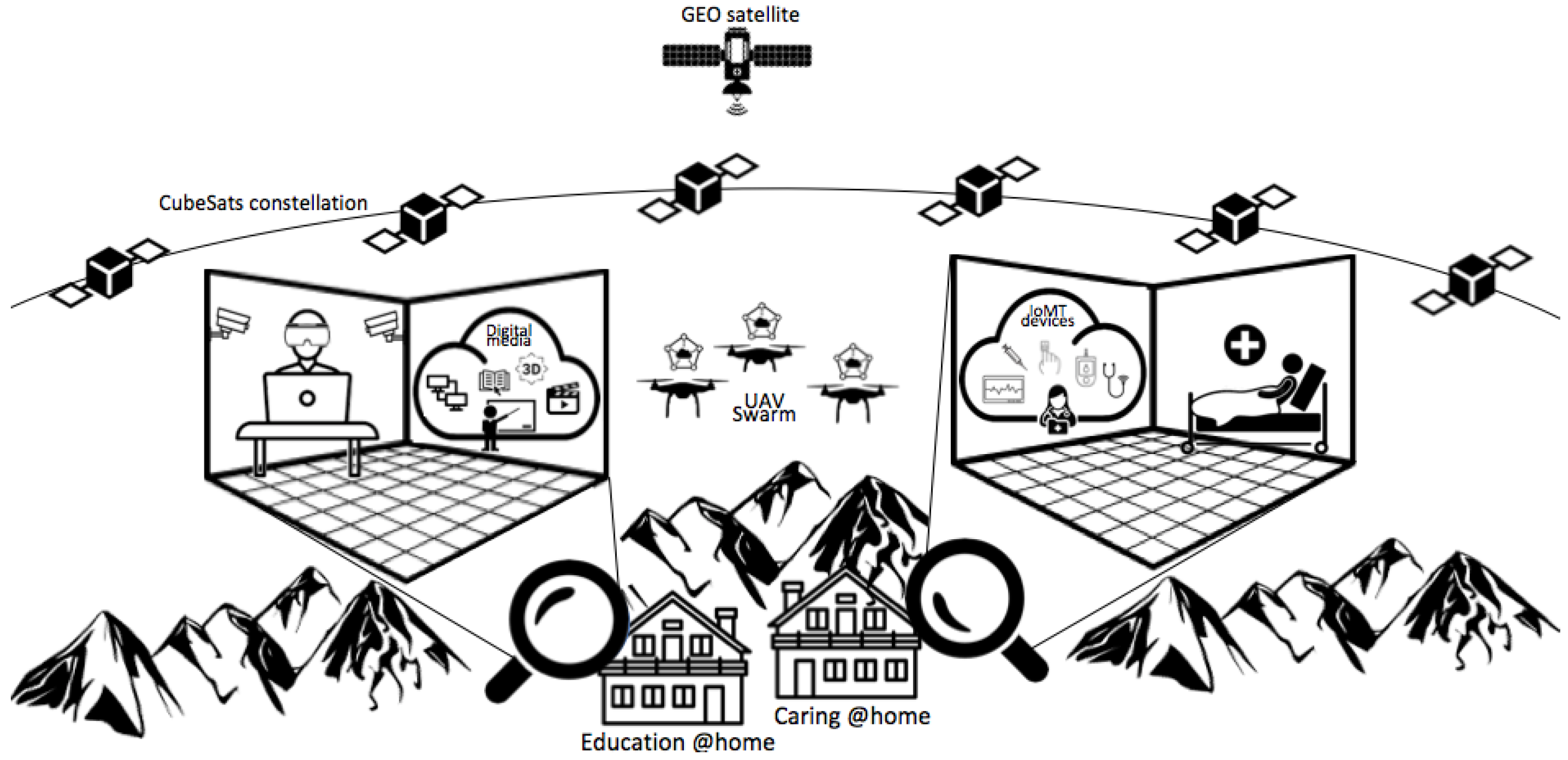6G to Take the Digital Divide by Storm: Key Technologies and Trends to Bridge the Gap
Abstract
:1. Introduction
2. The Evolution of the Digital Divide
3. The Technologies for Bridging the Service-Delivery Divide
3.1. Non-Terrestrial Networks
3.2. Exploiting Higher Frequencies
3.3. Device-to-Device
3.4. Multi-Access Edge Computing
4. The Technologies for Bridging the Service-Fruition Divide
4.1. Extended Reality
4.2. Brain-Computer Interfaces
4.3. Affective Computing
5. Artificial Intelligence: The Ultimate Breakthrough?
6. The 6G Services to “Connect” People
6.1. The eHealth Case
6.2. Education
7. Discussion and Conclusions
Author Contributions
Funding
Informed Consent Statement
Data Availability Statement
Conflicts of Interest
References
- Nokia. How Do We Create Inclusivity in a Digital Future? Building a Better World with Broadband Technologies; Technical Report, White Paper; Nokia: Espoo, Finland, 2020. [Google Scholar]
- Ericsson. Bridging the Digital Divide for an Inclusive Digital Economy; Technical Report, White Paper; Ericsson: Stockholm, Sweden, 2021. [Google Scholar]
- Huawei. TECH4ALL: Leaving No One behind in the Digital World; Technical Report; Huawei: Shenzhen, China, 2021. [Google Scholar]
- Cisco. Annual Internet Report (2018–2023); Technical Report, White Paper; Cisco: San Jose, CA, USA, 2020. [Google Scholar]
- Vodafone. Digital for Europe: Collaboration, Innovation, Transformation; Technical Report, White Paper; Vodafone: Berkshire, UK, 2021. [Google Scholar]
- Stelitano, L.; Doan, S.; Woo, A.; Diliberti, M.K.; Kaufman, J.H.; Henry, D. The Digital Divide and COVID-19: Teachers’ Perceptions of Inequities in Students’ Internet Access and Participation in Remote Learning; RAND Corporation: Santa Monica, CA, USA, 2020. [Google Scholar] [CrossRef]
- Saad, W.; Bennis, M.; Chen, M. A vision of 6G wireless systems: Applications, trends, technologies, and open research problems. IEEE Netw. 2019, 34, 134–142. [Google Scholar] [CrossRef] [Green Version]
- Suraci, C.; Pizzi, S.; Molinaro, A.; Araniti, G. MEC and D2D as Enabling Technologies for a Secure and Lightweight 6G eHealth System. IEEE Internet Things J. 2022, 9, 11524–11532. [Google Scholar] [CrossRef]
- Chaoub, A.; Giordani, M.; Lall, B.; Bhatia, V.; Kliks, A.; Mendes, L.; Rabie, K.; Saarnisaari, H.; Singhal, A.; Zhang, N.; et al. 6G for Bridging the Digital Divide: Wireless Connectivity to Remote Areas. IEEE Wirel. Commun. 2022, 69, 160–168. [Google Scholar] [CrossRef]
- Hidalgo, A.; Gabaly, S.; Morales-Alonso, G.; Urueña, A. The digital divide in light of sustainable development: An approach through advanced machine learning techniques. Technol. Forecast. Soc. Chang. 2020, 150, 119754. [Google Scholar] [CrossRef]
- Van Dijk, J.A. Digital divide: Impact of access. In The International Encyclopedia of Media Effects; Wiley: Hoboken, NJ, USA, 2017; pp. 1–11. [Google Scholar]
- Rinaldi, F.; Maattanen, H.L.; Torsner, J.; Pizzi, S.; Andreev, S.; Iera, A.; Koucheryavy, Y.; Araniti, G. Non-Terrestrial Networks in 5G & Beyond: A Survey. IEEE Access 2020, 8, 165178–165200. [Google Scholar]
- Dao, N.N.; Pham, Q.V.; Tu, N.H.; Thanh, T.T.; Bao, V.N.Q.; Lakew, D.S.; Cho, S. Survey on aerial radio access networks: Toward a comprehensive 6G access infrastructure. IEEE Commun. Surv. Tutor. 2021, 23, 1193–1225. [Google Scholar] [CrossRef]
- Polese, M.; Jornet, J.M.; Melodia, T.; Zorzi, M. Toward end-to-end, full-stack 6G terahertz networks. IEEE Commun. Mag. 2020, 58, 48–54. [Google Scholar] [CrossRef]
- Wu, Q.; Zhang, R. Towards smart and reconfigurable environment: Intelligent reflecting surface aided wireless network. IEEE Commun. Mag. 2019, 58, 106–112. [Google Scholar] [CrossRef] [Green Version]
- Mu, X.; Liu, Y.; Guo, L.; Lin, J.; Poor, H.V. Intelligent reflecting surface enhanced multi-UAV NOMA networks. IEEE J. Sel. Areas Commun. 2021, 39, 3051–3066. [Google Scholar] [CrossRef]
- Zaidi, Z.; Friderikos, V.; Yousaf, Z.; Fletcher, S.; Dohler, M.; Aghvami, H. Will SDN be part of 5G? IEEE Commun. Surv. Tutor. 2018, 20, 3220–3258. [Google Scholar] [CrossRef] [Green Version]
- Zhang, S.; Liu, J.; Guo, H.; Qi, M.; Kato, N. Envisioning device-to-device communications in 6G. IEEE Netw. 2020, 34, 86–91. [Google Scholar] [CrossRef] [Green Version]
- Jameel, F.; Hamid, Z.; Jabeen, F.; Zeadally, S.; Javed, M.A. A survey of device-to-device communications: Research issues and challenges. IEEE Commun. Surv. Tutor. 2018, 20, 2133–2168. [Google Scholar] [CrossRef]
- Taleb, T.; Samdanis, K.; Mada, B.; Flinck, H.; Dutta, S.; Sabella, D. On multi-access edge computing: A survey of the emerging 5G network edge cloud architecture and orchestration. IEEE Commun. Surv. Tutor. 2017, 19, 1657–1681. [Google Scholar] [CrossRef] [Green Version]
- Saarnisaari, H.; Dixit, S.; Alouini, M.S.; Chaoub, A.; Giordani, M.; Kliks, A.; Matinmikko-Blue, M.; Zhang, N.; Agrawal, A.; Andersson, M.; et al. A 6G white paper on connectivity for remote areas. arXiv 2020, arXiv:2004.14699. [Google Scholar]
- Akyildiz, I.F.; Guo, H. Wireless Extended Reality (XR): Challenges and New Research Directions. ITU J. Future Evol. Technol. 2022, 3. [Google Scholar]
- Narayanan, A.; Ramadan, E.; Carpenter, J.; Liu, Q.; Liu, Y.; Qian, F.; Zhang, Z.L. A first look at commercial 5G performance on smartphones. In Proceedings of the Web Conference 2020, New York, NY, USA, 20–24 April 2020; pp. 894–905. [Google Scholar]
- Oleksiuk, V.P.; Oleksiuk, O.R. Exploring the Potential of Augmented Reality for Teaching School Computer Science. In Proceedings of the 3rd International Workshop on Augmented Reality in Education, Kryvyi Rih, Ukraine, 13 May 2020. [Google Scholar]
- Chen, Y.; Zhou, Z.; Cao, M.; Liu, M.; Lin, Z.; Yang, W.; Yang, X.; Dhaidhai, D.; Xiong, P. Extended Reality (XR) and Telehealth Interventions for Children or Adolescents with Autism Spectrum Disorder: Systematic Review of Qualitative and Quantitative Studies. Neurosci. Biobehav. Rev. 2022, 138, 104683. [Google Scholar] [CrossRef]
- Mahmoud, H.H.H.; Amer, A.A.; Ismail, T. 6G: A comprehensive survey on technologies, applications, challenges, and research problems. Trans. Emerg. Telecommun. Technol. 2021, 32, e4233. [Google Scholar] [CrossRef]
- Jafri, S.R.A.; Hamid, T.; Mahmood, R.; Alam, M.A.; Rafi, T.; Haque, M.Z.U.; Munir, M.W. Wireless brain computer interface for smart home and medical system. Wirel. Pers. Commun. 2019, 106, 2163–2177. [Google Scholar] [CrossRef]
- Anitha, T.; Shanthi, N.; Sathiyasheelan, R.; Emayavaramban, G.; Rajendran, T. Brain-computer interface for persons with motor disabilities—A review. Open Biomed. Eng. J. 2019, 13, 127–133. [Google Scholar] [CrossRef]
- Picard, R.W. Affective Computing; MIT Press: Cambridge, MA, USA, 2000. [Google Scholar]
- Politou, E.; Alepis, E.; Patsakis, C. A survey on mobile affective computing. Comput. Sci. Rev. 2017, 25, 79–100. [Google Scholar] [CrossRef]
- Yadegaridehkordi, E.; Noor, N.F.B.M.; Ayub, M.N.B.; Affal, H.B.; Hussin, N.B. Affective computing in education: A systematic review and future research. Comput. Educ. 2019, 142, 103649. [Google Scholar] [CrossRef]
- Kato, N.; Mao, B.; Tang, F.; Kawamoto, Y.; Liu, J. Ten challenges in advancing machine learning technologies toward 6G. IEEE Wirel. Commun. 2020, 27, 96–103. [Google Scholar] [CrossRef]
- Chen, M.; Challita, U.; Saad, W.; Yin, C.; Debbah, M. Artificial neural networks-based machine learning for wireless networks: A tutorial. IEEE Commun. Surv. Tutor. 2019, 21, 3039–3071. [Google Scholar] [CrossRef] [Green Version]
- Pisoni, G.; Díaz-Rodríguez, N.; Gijlers, H.; Tonolli, L. Human-centred artificial intelligence for designing accessible cultural heritage. Appl. Sci. 2021, 11, 870. [Google Scholar] [CrossRef]
- Giordani, M.; Polese, M.; Mezzavilla, M.; Rangan, S.; Zorzi, M. Toward 6G networks: Use cases and technologies. IEEE Commun. Mag. 2020, 58, 55–61. [Google Scholar] [CrossRef]
- Senk, S.; Ulbricht, M.; Tsokalo, I.; Rischke, J.; Li, S.C.; Speidel, S.; Nguyen, G.T.; Seeling, P.; Fitzek, F.H. Healing Hands: The Tactile Internet in Future Tele-Healthcare. Sensors 2022, 22, 1404. [Google Scholar] [CrossRef]
- Wang, L.; Huang, M.; Yang, R.; Liang, H.N.; Han, J.; Sun, Y. Survey of Movement Reproduction in Immersive Virtual Rehabilitation. IEEE Trans. Vis. Comput. Graph. 2022. [Google Scholar] [CrossRef]
- El-Sherif, D.M.; Abouzid, M.; Elzarif, M.T.; Ahmed, A.A.; Albakri, A.; Alshehri, M.M. Telehealth and Artificial Intelligence insights into healthcare during the COVID-19 pandemic. Healthcare 2022, 10, 385. [Google Scholar] [CrossRef]
- Alrubei, S.M.; Ball, E.; Rigelsford, J.M. A Secure Blockchain Platform for Supporting AI-Enabled IoT Applications at the Edge Layer. IEEE Access 2022, 10, 18583–18595. [Google Scholar] [CrossRef]
- Nasser, N.; Fadlullah, Z.M.; Fouda, M.M.; Ali, A.; Imran, M. A lightweight federated learning based privacy preserving B5G pandemic response network using unmanned aerial vehicles: A proof-of-concept. Comput. Netw. 2022, 205, 108672. [Google Scholar] [CrossRef]
- West, D.M. Digital divide: Improving Internet access in the developing world through affordable services and diverse content. Cent. Technol. Innov. Brookings 2015, 1–30. [Google Scholar]
- Nagpal, L.; Samdani, K. Project Loon: Innovating the connectivity worldwide. In Proceedings of the 2017 2nd IEEE International Conference on Recent Trends in Electronics, Information & Communication Technology (RTEICT), Bangalore, India, 19–20 May 2017; IEEE: Piscataway, NJ, USA, 2017; pp. 1778–1784. [Google Scholar]
- Martínez, F.; Barraza, C.; González, N.; González, J. KAPEAN: Understanding affective states of children with ADHD. J. Educ. Technol. Soc. 2016, 19, 18–28. [Google Scholar]
- Zweifach, S.M.; Triola, M.M. Extended reality in medical education: Driving adoption through provider-centered design. Digit. Biomarkers 2019, 3, 14–21. [Google Scholar] [CrossRef] [PubMed]
- Pomerantz, J. Teaching and learning with extended reality technology. In Information and Technology Transforming Lives: Connection, Interaction, Innovation; University of Osijek: Osijek, Croatia, 2019; pp. 137–157. [Google Scholar]
- Baldé, C.; Kuehr, R. The Impact of the COVID-19 Pandemic on One-Waste in the First Three Quarters of 2020; Technical Report; United Nations University (UNU)/United Nations Institute for Training and Research (UNITAR): Bonn, Germany, 2020. [Google Scholar]
- Yrjölä, S. Decentralized 6G Business Models. In Proceedings of the 6G Wireless Summit, Levi, Finland, 26 April 2019. [Google Scholar]




| Technology | Service-Delivery | Service-Fruition |
|---|---|---|
| Affective Computing | ✗ | ✓ |
| Artificial Intelligence (AI) | ✓ | ✓ |
| Brain-Computer Interface (BCI) | ✗ | ✓ |
| Device-to-Device (D2D) | ✓ | ✗ |
| Exploiting Higher Frequencies | ✓ | ✗ |
| Extended Reality (XR) | ✗ | ✓ |
| Multi-access Edge Computing (MEC) | ✓ | ✗ |
| Non-Terrestrial Networks (NTN) | ✓ | ✗ |
| 6G Technology | AI Candidates |
|---|---|
| Sensor Networks and Edge Systems | Reinforcement Learning, Unimodal & Multimodal Classification, Autoregressive Models |
| SDN & D2D | (Deep) Reinforcement Learning, Multimodal Classification, Deep Neural Networks |
| Drone Swarms | Reinforcement Learning, Unsupervised Learning, Agent-based models |
| Extended Reality | Computer Vision, Autoregressive models |
| Brain-Computer Interfaces | Recurrent Neural Networks, Autoregressive Models, Continual Learning |
| Affective Computing | Convolutional Neural Networks, Multimodal Classification, Natural Language Processing |
Publisher’s Note: MDPI stays neutral with regard to jurisdictional claims in published maps and institutional affiliations. |
© 2022 by the authors. Licensee MDPI, Basel, Switzerland. This article is an open access article distributed under the terms and conditions of the Creative Commons Attribution (CC BY) license (https://creativecommons.org/licenses/by/4.0/).
Share and Cite
Suraci, C.; Pizzi, S.; Montori, F.; Di Felice, M.; Araniti, G. 6G to Take the Digital Divide by Storm: Key Technologies and Trends to Bridge the Gap. Future Internet 2022, 14, 189. https://doi.org/10.3390/fi14060189
Suraci C, Pizzi S, Montori F, Di Felice M, Araniti G. 6G to Take the Digital Divide by Storm: Key Technologies and Trends to Bridge the Gap. Future Internet. 2022; 14(6):189. https://doi.org/10.3390/fi14060189
Chicago/Turabian StyleSuraci, Chiara, Sara Pizzi, Federico Montori, Marco Di Felice, and Giuseppe Araniti. 2022. "6G to Take the Digital Divide by Storm: Key Technologies and Trends to Bridge the Gap" Future Internet 14, no. 6: 189. https://doi.org/10.3390/fi14060189
APA StyleSuraci, C., Pizzi, S., Montori, F., Di Felice, M., & Araniti, G. (2022). 6G to Take the Digital Divide by Storm: Key Technologies and Trends to Bridge the Gap. Future Internet, 14(6), 189. https://doi.org/10.3390/fi14060189










